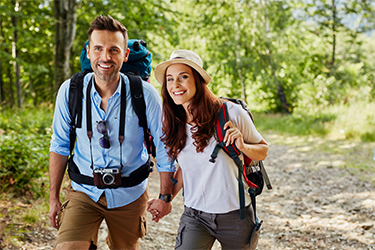
Take a hike!
- Posted on:
- Posted in: Health
Preparation is key to having a fun, safe commune with nature
The end of summer and early fall provides a wonderful opportunity to explore the great outdoors. Whether you’re an accomplished hiker and relish a challenging workout (just short of what some would call mountain climbing) or simply heading to a local nature park for a long afternoon walk with Fido, it’s important to know the basics of being out on nature’s trails for any length of time. Mostly, it just takes some common sense.
Ten essential things you should bring on every hike
According to the American Hiking Society, these are the 10 essentials of hiking:
1) Appropriate footwear. For a short day hike that doesn’t involve a heavy pack or technical terrain, trail shoes are great. For longer hikes, carrying heavier loads or more technical terrain, hiking boots offer more support.
2) Map and compass/GPS. A map and compass not only tell you where you are and how far you have to go, it can also help you find campsites, water and an emergency exit route in case of an accident. While GPS units are very useful, always carry a map and compass as a backup.
3) Extra water and a way to purify it. Without enough water, your body’s muscles and organs simply can’t perform as well. Consuming too little water will not only make you thirsty, but susceptible to hypothermia and altitude sickness.
4) Extra food. Any number of things could keep you out longer than expected: getting lost, enjoying time by a stream, an injury or difficult terrain. Extra food will help keep up energy and morale.
5) Rain gear and extra clothing. Because the weatherman is not always right. Dressing in layers allows you to adjust to changing weather and activity levels. Two rules: avoid cotton (it keeps moisture close to your skin) and always carry a hat.
6) Safety items: fire, light and a whistle. The warmth of a fire and a hot drink can help prevent hypothermia. Fires are also a great way to signal for help if you get lost. If lost, you’ll also want the whistle as it is more effective than using your voice to call for help (use three short bursts). And just in case you’re out later than planned, a flashlight/headlamp is a must-have item to see your map and where you’re walking.
7) First aid kit. Prepackaged first aid kits for hikers are available at any outfitter. Double your effectiveness with knowledge: take a first aid class with the American Red Cross or a Wilderness First Aid class.
8) Knife or multi-purpose tool. These enable you to cut strips of cloth into bandages, remove splinters, fix broken eyeglasses and perform a whole host of repairs on malfunctioning gear.
9) Sun screen and sun glasses. Especially above the tree line when there is a skin-scorching combination of sun and snow, you’ll need sunglasses to prevent snow blindness and sunscreen to prevent sunburn.
10) Daypack/backpack. You’ll want something you can carry comfortably and that has the features designed to keep you hiking smartly. Don’t forget the rain cover; some packs come with one built-in. Keep the other essentials in the pack and you’ll always be ready to hit the trail safely.
BONUS 1: Trash Bag. This 11th piece of gear is essential to making sure that the trails you love stay beautiful for generations to come. A ziplock bag is a great option as well for keeping the trash you pick up along the trail separate from the rest of your gear.
BONUS 2: Personal locater beacons. REI, the retail hiking equipment giant, suggests carrying one of the following for detection: personal locator beacon, satellite messengers, signal mirror, whistle or strobe light. These devices help search and rescue teams identify your location should you become lost, sick or injured while hiking in remote locations.
The 10 most common hiking injuries
The Outdoor Federation compares hiking with high impact exercises like running and ultrarunning. As with those intense sports, starting out slowly and getting into shape for a rigorous hike is necessary to prevent a twisted ankle or sore joint, hip or knee. Both experienced and novice hikers may find themselves suffering from any one or more of these other ailments:
- Blisters, muscle cramping, chafing, sunburn, bug bites, abrasions and minor scrapes, diarrhea or constipation, exhaustion, and poison ivy.
Links to hiking injuries, prevention and treatment
– American Hiking Society https://americanhiking.org/
– Outdoor Federation
https://www.outdoorfederation.com/top-10-most-common-hiking-injuries/
Find hiking trails in and around Tacoma
– Hiking Project, Tacoma
https://www.hikingproject.com/directory/8010838/tacoma
By Holly Harmon for Puget Sound Orthopaedics
SHARE


